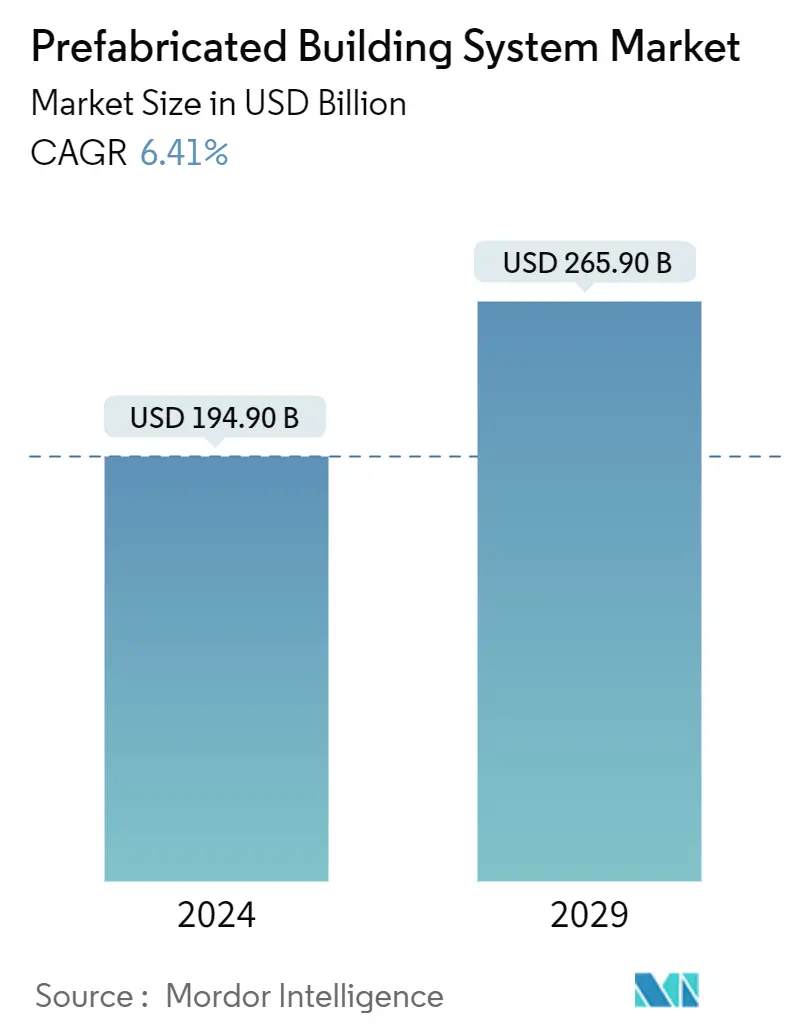Market Size of Prefabricated Building System Industry

| Study Period | 2019 - 2029 |
| Market Size (2024) | USD 194.90 Billion |
| Market Size (2029) | USD 265.90 Billion |
| CAGR (2024 - 2029) | 6.41 % |
| Fastest Growing Market | Asia Pacific |
| Largest Market | Asia Pacific |
Major Players
*Disclaimer: Major Players sorted in no particular order |
Prefabricated Building System Market Analysis
The Prefabricated Building System Market size is estimated at USD 194.90 billion in 2024, and is expected to reach USD 265.90 billion by 2029, growing at a CAGR of 6.41% during the forecast period (2024-2029).
The COVID-19 outbreak negatively impacted the market. Construction work stopped worldwide, especially in significant construction hubs like China and India. However, the market is projected to grow steadily in the forecast period due to global construction sector growth.
- Over the short term, increasing demand for building construction in the Asia-Pacific region is one of the major factors driving the growth of the market studied.
- On the flip side, technical issues associated with prefabrication, such as weak joints and poor thermal insulation performance, are expected to hinder the growth of the market.
- However, the implementation of building information modeling is anticipated to provide numerous opportunities over the forecast period.
Prefabricated Building System Industry Segmentation
The building and construction industry uses prefabricated building systems, which are modular constructions or assemblies of parts and components. Typically, these systems are created and put together in factories before being delivered to the construction site, where they are installed or used to create structures. These systems are made from a variety of materials, including metal, wood, glass, plastic, concrete, etc. The prefabricated building system market is segmented based on dimensions, application, and geography. The market is segmented by dimensions into skeleton, panel, cellular, and combined systems. By application, the market is segmented into residential and non-residential. The report offers market sizes and forecasts for 18 countries across major regions. For each segment, market sizing and forecasts have been done on the basis of value (USD) for all the above segments.
| Dimensions | |
| Skeleton System | |
| Panel System | |
| Cellular System | |
| Combined System |
| Application | |||||
| Residential | |||||
|
| Geography | |||||||||
| |||||||||
| |||||||||
| |||||||||
| |||||||||
|
Prefabricated Building System Market Size Summary
The prefabricated building system market is poised for significant growth over the forecast period, driven by increasing demand in the Asia-Pacific region and the industrial sector. The market's expansion is supported by the growing popularity of off-site construction, which offers benefits such as accelerated project timelines, cost efficiency, and enhanced safety. Despite challenges like technical issues related to prefabrication, the implementation of building information modeling is expected to create new opportunities. The market is also witnessing increased demand in the industrial and institutional sectors, with governments in regions like the United Kingdom and the United States investing in new construction and renovation projects, further bolstering market growth.
The Asia-Pacific region holds a dominant position in the global prefabricated building system market, fueled by robust residential and industrial activities. China's significant infrastructure development and India's government-supported housing initiatives are key contributors to the region's market demand. The advantages of modular buildings, such as faster completion times and cost savings, are also driving market growth. Additionally, Japan's focus on major infrastructure projects underscores the region's positive growth trends. The market is characterized by its fragmented nature, with major players like Algeco Scotsman and Skyline Champion Corporation actively participating in the market, as evidenced by strategic acquisitions aimed at strengthening their positions in the offsite and modern construction sectors.
Prefabricated Building System Market Size - Table of Contents
-
1. MARKET DYNAMICS
-
1.1 Drivers
-
1.1.1 Increasing Demand for Building Construction in Asia-Pacific
-
1.1.2 Supportive Government Incentives and Policies
-
1.1.3 Other Drivers
-
-
1.2 Restraints
-
1.2.1 Technical Issues Associated with Prefabrication
-
1.2.2 Other Restraints
-
-
1.3 Industry Value Chain Analysis
-
1.4 Porter's Five Forces Analysis
-
1.4.1 Bargaining Power of Suppliers
-
1.4.2 Bargaining Power of Buyers
-
1.4.3 Threat of New Entrants
-
1.4.4 Threat of Substitute Products and Services
-
1.4.5 Degree of Competition
-
-
-
2. MARKET SEGMENTATION (Market Size in Value)
-
2.1 Dimensions
-
2.1.1 Skeleton System
-
2.1.2 Panel System
-
2.1.3 Cellular System
-
2.1.4 Combined System
-
-
2.2 Application
-
2.2.1 Residential
-
2.2.2 Non-Residential
-
2.2.2.1 Infrastructure
-
2.2.2.2 Commercial
-
2.2.2.3 Industrial/Institutional
-
-
-
2.3 Geography
-
2.3.1 Asia-Pacific
-
2.3.1.1 China
-
2.3.1.2 India
-
2.3.1.3 Japan
-
2.3.1.4 South Korea
-
2.3.1.5 ASEAN Countries
-
2.3.1.6 Rest of Asia-Pacific
-
-
2.3.2 North America
-
2.3.2.1 United States
-
2.3.2.2 Canada
-
2.3.2.3 Mexico
-
-
2.3.3 Europe
-
2.3.3.1 Germany
-
2.3.3.2 United Kingdom
-
2.3.3.3 Italy
-
2.3.3.4 France
-
2.3.3.5 Russia
-
2.3.3.6 Spain
-
2.3.3.7 Rest of Europe
-
-
2.3.4 South America
-
2.3.4.1 Brazil
-
2.3.4.2 Argentina
-
2.3.4.3 Rest of South America
-
-
2.3.5 Middle-East and Africa
-
2.3.5.1 Saudi Arabia
-
2.3.5.2 South Africa
-
2.3.5.3 Rest of Middle-East and Africa
-
-
-
Prefabricated Building System Market Size FAQs
How big is the Prefabricated Building System Market?
The Prefabricated Building System Market size is expected to reach USD 194.90 billion in 2024 and grow at a CAGR of 6.41% to reach USD 265.90 billion by 2029.
What is the current Prefabricated Building System Market size?
In 2024, the Prefabricated Building System Market size is expected to reach USD 194.90 billion.

